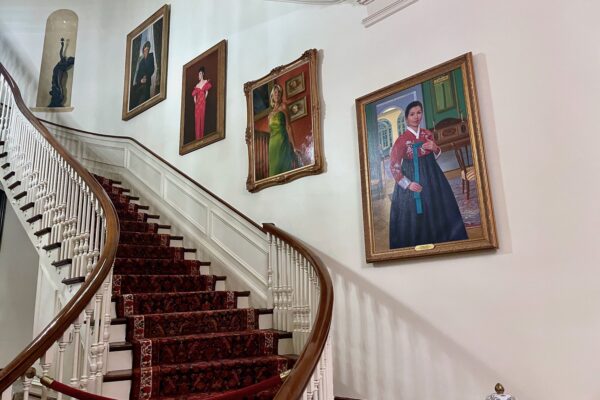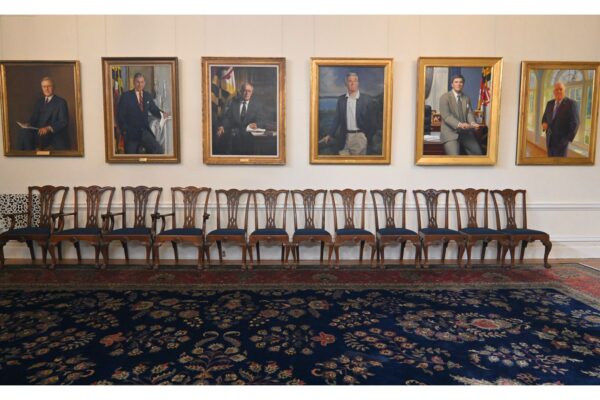This content was republished with permission from WTOP’s news partners at Maryland Matters. Sign up for Maryland Matters’ free email subscription today.
The portraits of a recent former governor and his wife will soon take their places among their peers.
Gov. Martin O’Malley (D) and his wife, retired District Court Judge Catherine Curran O’Malley, haven’t lived in the governor’s mansion since 2015. Their portraits are absent from both the State House and the mansion.
That will soon change.
The O’Malleys will be the guests of Gov. Wes Moore (D) and his wife Dawn Flythe Moore on July 19 for an invitation-only unveiling inside Government House, according to an invitation obtained by Maryland Matters.
A spokesperson for the governor confirmed the unveiling event.
Some details are known about the portraits.
Former Governor O’Malley’s portrait was painted by Jorge Alberto Gonzalez in 2017. Judge O’Malley’s portrait was painted by Hans Guerin in 2020. Both portraits were received by Maryland State Archive’s Commission on Artistic Property in July 2023, according to Maryland State Archivist Elaine Rice Bachmann.
Gonzalez, a Cuban-born artist, emigrated to the U.S. with his family in 1965. He studied at the Schuler School of Fine Arts in Baltimore and painted O’Malley’s official portrait as Mayor of Baltimore in 2008.
Guerin graduated from Salisbury University in 2000 and is currently the assistant director and an instructor at the Schuler School of Fine Arts in Baltimore.
“The Commission on Artistic Property is pleased to be adding these official portraits to the state-owned art collection,” said Bachmann. “Both are being unveiled at the event in Government House, but each will be subsequently installed in their respective locations: Judge O’Malley in the stairwell of Government House; and Governor O’Malley in the Governor’s Reception Room of the State House.”
Both portraits were commissioned and paid for with donations to a nonprofit established by the O’Malleys, according to Bachmann.
A list of donors was not immediately available.
The cost of the portraits is unknown. No images of the portraits will be available until they are unveiled next week.
A spokesperson for O’Malley was not immediately available for comment.
Traditionally, governors and their wives are responsible for providing their own official portraits — and paying for them. They are typically privately funded through donations to a nonprofit established by each individual governor.

The paintings are typically completed before the end of a governor’s term in office. They are then installed: the governor’s portrait typically hangs in the Governor’s reception Room while the first lady is displayed inside the mansion.
In recent years, it has not been uncommon for departing first couples to officially unveil those portraits right before leaving office or soon after.
That did not happen with O’Malley. Some believe the former governor, a Democrat, was loath to unveil his portrait while Gov. Larry Hogan (R) was in office.
Hogan may have extended that self-imposed image exile by winning a second term in 2018.
But with a new Democrat in the governor’s office, O’Malley’s time has come.
Hogan and his wife Yumi celebrated their own portraits in a similar private gathering in the mansion last May.
The portraits hung in the mansion, publicly visible on guided tours of Government House for most of the year. They were unveiled again eight months later in a gathering in the Governor’s Reception Room.
The portraits commissioned by the Hogans cost a combined $100,000, according to the Maryland State Archives, which is the official conservator of the portraits and the state’s art collection.
Hogan’s portrait, painted by Cedric Egeli, is notable because it is the only official portrait of a state executive to feature the iconic dome of the Maryland State House.
Egeli, a Maryland-based impressionist painter renowned for his mastery of light, also painted the portrait of Gov. Blair Lee III (D).
Yumi Hogan, an artist in her own right, oversaw the projects. She teaches at the Maryland Institute College of Art in Baltimore. Her official portrait, painted by Jinchul Kim, features the country’s first Asian American first lady wearing a traditional Korean hanbok.
The portrait of Yumi Hogan by Kim, a figurative painter and a professor of art at Salisbury University, is the first in the state’s collection to be painted by a Korean American artist.
Governors have a say in what portraits are installed in the reception room and inside the governor’s office suite.
During Hogan’s time in office, he asked for the official portrait of Theodore McKeldin, the state’s last two-term Republican governor, to hang in the suite outside the door to his private office.
When Moore entered office, McKeldin was removed. In its place is a large photograph of Moore leading a procession up Francis Street to the State House on the morning of his inauguration.

Current tradition is that when a new official portrait of a former governor is installed, the remaining portraits advance one position. The portrait on the far side of the room near the entrance to the governor’s office suite is typically removed.
Currently, portraits of eight modern governors including Hogan hang inside the reception room. When Hogan’s portrait was hung, he displaced former Gov. J. Millard Tawes, whose portrait was placed in storage.
O’Malley’s portrait, when it finally joins the others in the reception room, will displace disgraced Republican former Gov. Spiro T. Agnew (R), who resigned as vice president in 1972.
Agnew’s portrait “will initially go into storage until another public location is determined for its display,” said Bachmann.
Agnew’s portrait was removed in 1979. Gov. Parris N. Glendening (D) returned it to the reception room in the spring of 1995, telling the Baltimore Sun that it was an effort to be faithful to history.
“It is not up to us to alter history. This is not an Orwellian future where history can change. We learn from history, warts and all,” Glendening told The Baltimore Sun that year.
Some believe Glendening was also motivated to irritate former Gov. William Donald Schaefer (D).
Glendening and Schaefer had a bitter political rivalry. And even though Schaefer’s portrait was completed and he left office in 1995, his portrait sat in storage until December 1996.
Glendening unveiled his portrait before leaving office at the end of his second term. It is unique because it provides a less formal view of the governor. Instead of in an office wearing a suit and tie like his predecessors, Glendening is shown wearing a golf shirt and jacket standing in the Blackwater National Wildlife Refuge.







